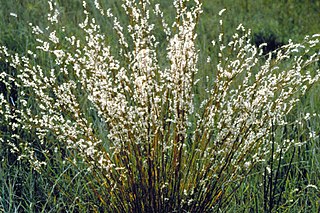
Dichanthelium is genus of flowering plants of the grass family, Poaceae. They are known commonly as rosette grasses and panicgrasses.

The Andropogoneae, sometimes called the sorghum tribe, are a large tribe of grasses (family Poaceae) with roughly 1,200 species in 90 genera, mainly distributed in tropical and subtropical areas. They include such important crops as maize (corn), sugarcane, and sorghum. All species in this tribe use C4 carbon fixation, which makes them competitive under warm, high-light conditions.

Axonopus is a genus of plants in the grass family, known generally as carpet grass. They are native primarily to the tropical and subtropical regions of the Americas with one species in tropical Africa and another on Easter Island. They are sometimes rhizomatous and many are tolerant of periodic submersion.

Chloris is a widespread genus of monophyletic grasses belonging to the family Poaceae, known generally as windmill grass or finger grass. The genus is found worldwide, but especially in the tropical and subtropical regions, and more often in the Southern Hemisphere. The species are variable in morphology, but in general, the plants are less than 0.5 m in height. They bear inflorescences shaped like umbels, with several plumes lined with rows of spikelets. The genus is characterized by the series of sterile florets above the lowest fertile ones, spikes usually 4–10 in numbers, approximated or in a slightly separated series of 10–20 spikes, rarely an indefinite numbers of terminal spikes. In India, 11 species are known to occur in which only two are endemic viz. Chloris wightiana Nees ex Steud. and Chloris bournei Rangachariar & Tadulingam.

Raddia is a genus of South American plants in the grass family, most of the species found only in Brazil.
Andropterum is a genus of African plants in the grass family. There is only one known species, Andropterum stolzii, native to Zimbabwe, Zambia, Mozambique, Tanzania, Malawi and Burundi.
Lophacme is a genus of African plants in the grass family.

Sclerodactylon is a genus of plants in the grass family, native to eastern Africa and to various islands in the Indian Ocean.

Sorghastrum is a genus of grasses, native to Africa and the Americas.

Steinchisma is a genus of plants in the grass family, native to the Americas but a few of them naturalized in Africa.
Streptostachys is a genus of South American plants in the grass family.
Diandrolyra is a genus of Brazilian plants in the grass family.
- Diandrolyra bicolorStapf - Espírito Santo
- Diandrolyra pygmaeaSoderstr. & Zuloaga ex R.P.Oliveira & L.G.Clark - Bahia
- Diandrolyra tatianaeSoderstr. & Zuloaga - São Paulo, Bahia, Rio de Janeiro, Espírito Santo

Urochloa, commonly known as signalgrass, is a genus of plants in the grass family, native to tropical and subtropical regions of Eurasia, Africa, Australia, the Americas, and various islands.
Gerritea is a genus of Bolivian plants in the family Poaceae. The only known species is Gerritea pseudopetiolata, native to La Paz Department in Bolivia.
Renvoizea is a genus of plants in the grass family.
Rupichloa is a genus of Brazilian plants in the grass family.









